Fertility of Gabbroic Intrusions in the Paleoproterozoic Lynn Lake Greenstone Belt, Manitoba, Canada: Insights from Field Relationships, Geochemical and Metallogenic Characteristics
Abstract
:1. Introduction

2. Regional Geology

3. Geological Settings
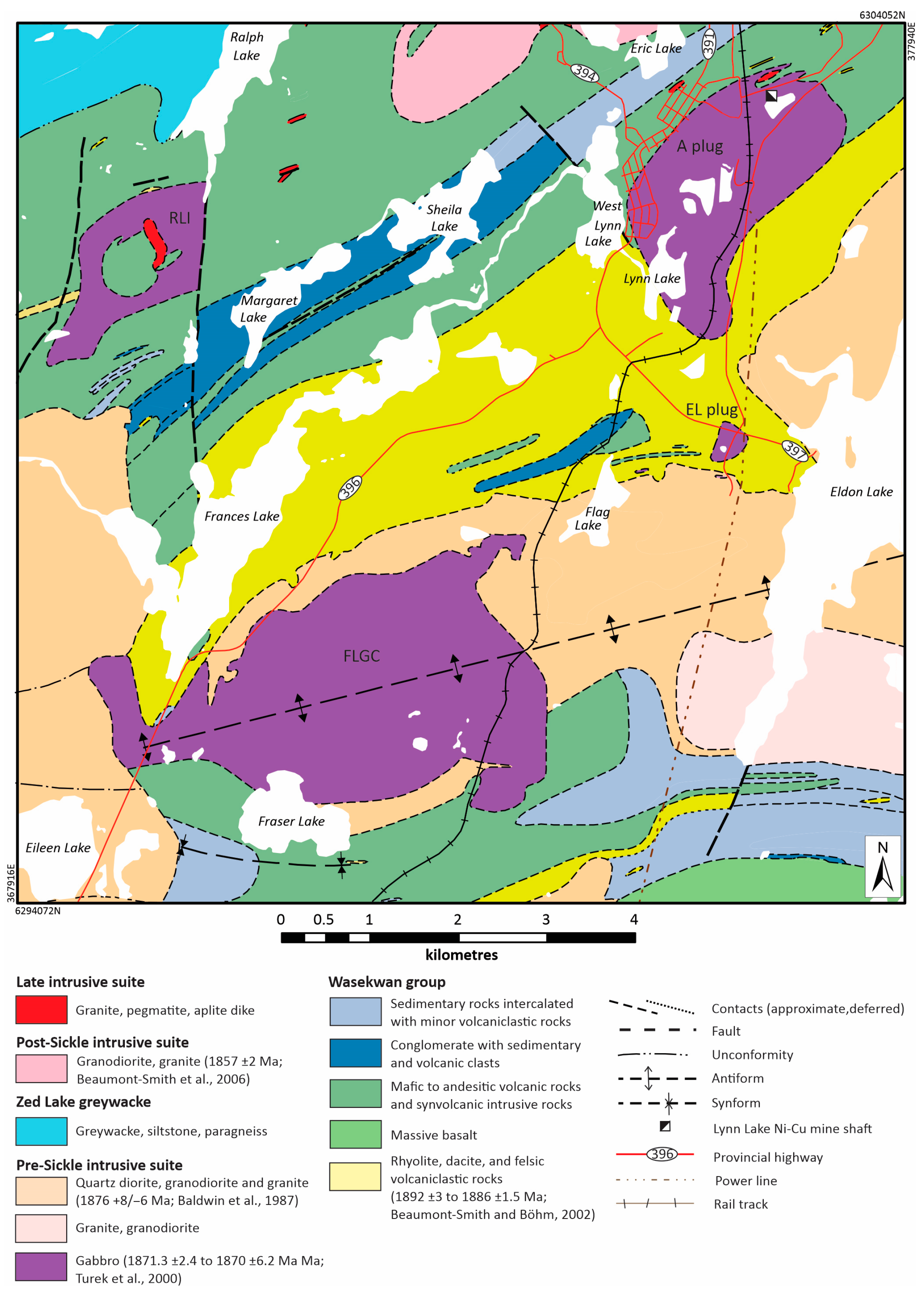
3.1. Lynn Lake Gabbroic Intrusion
3.1.1. A Plug
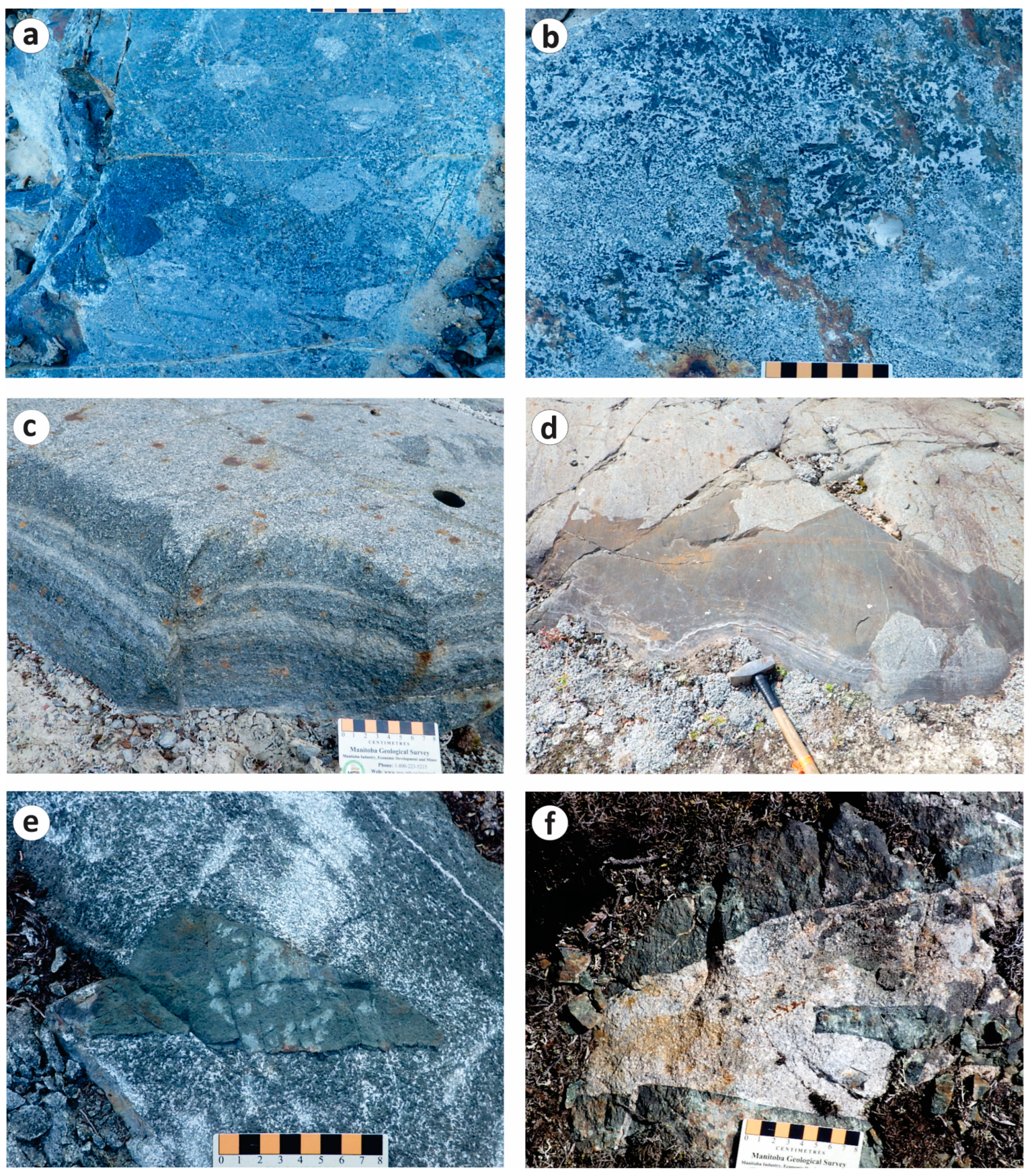
3.1.2. EL Plug
3.2. Fraser Lake Gabbro Complex
4. Methods
5. Geochemical Characteristics
5.1. Classification
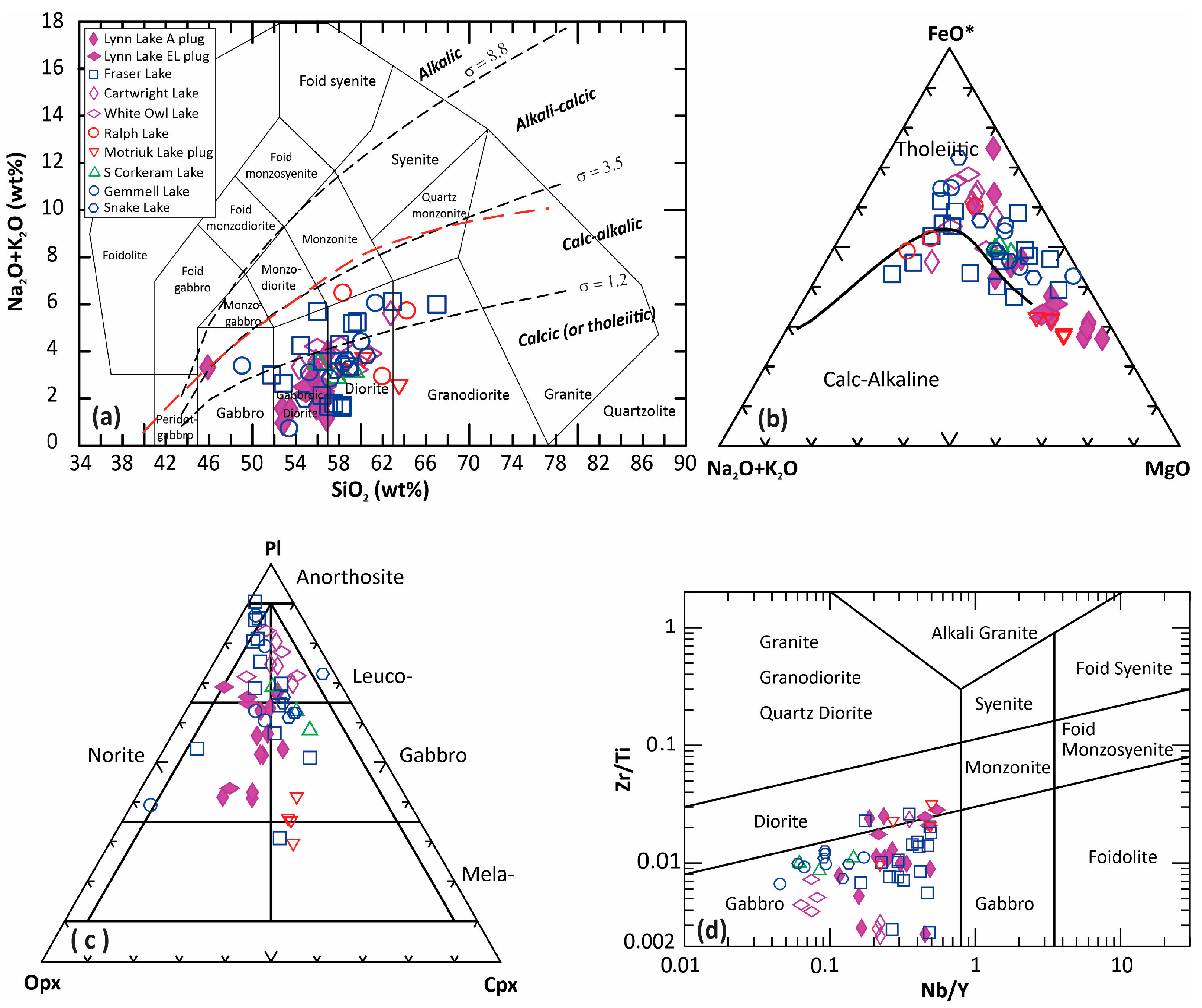
5.2. Trace and Rare Earth Element Patterns

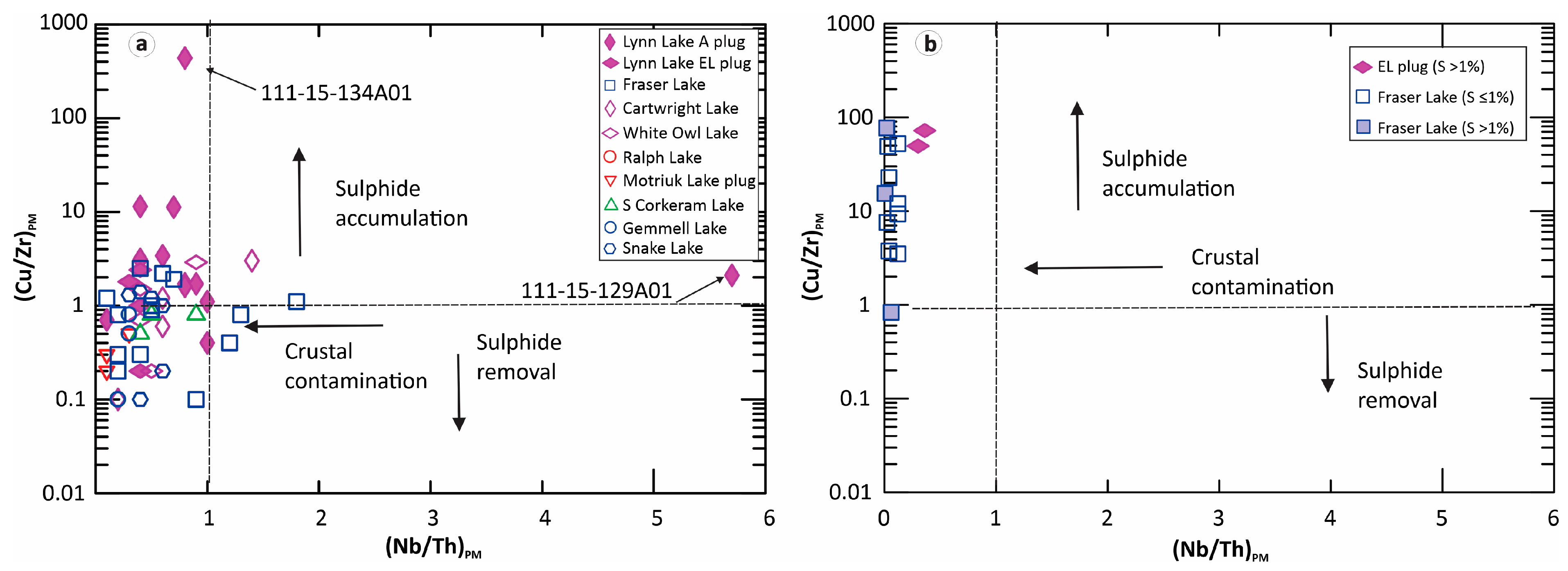
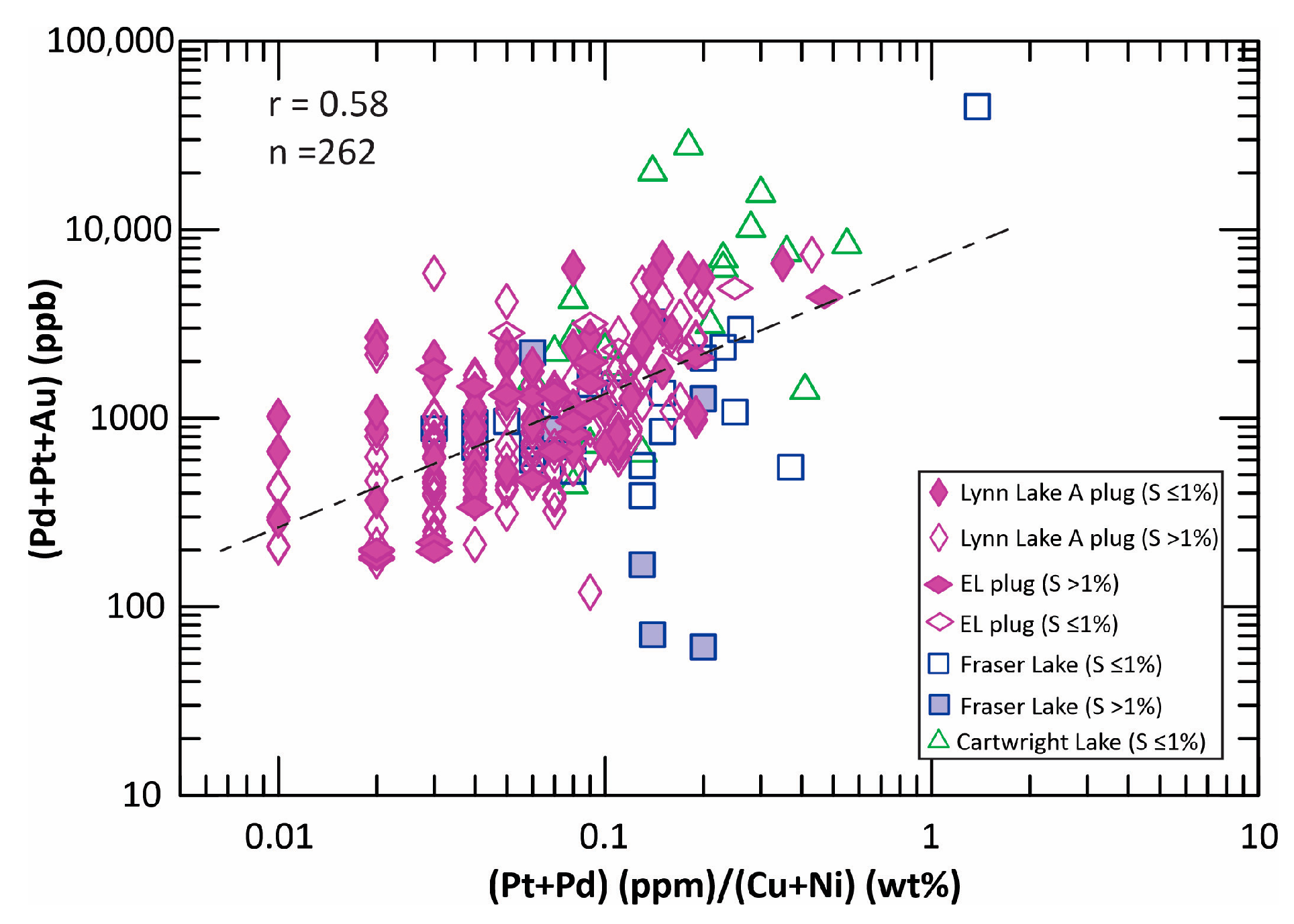
5.3. Highly Siderophile Elements (HSEs)
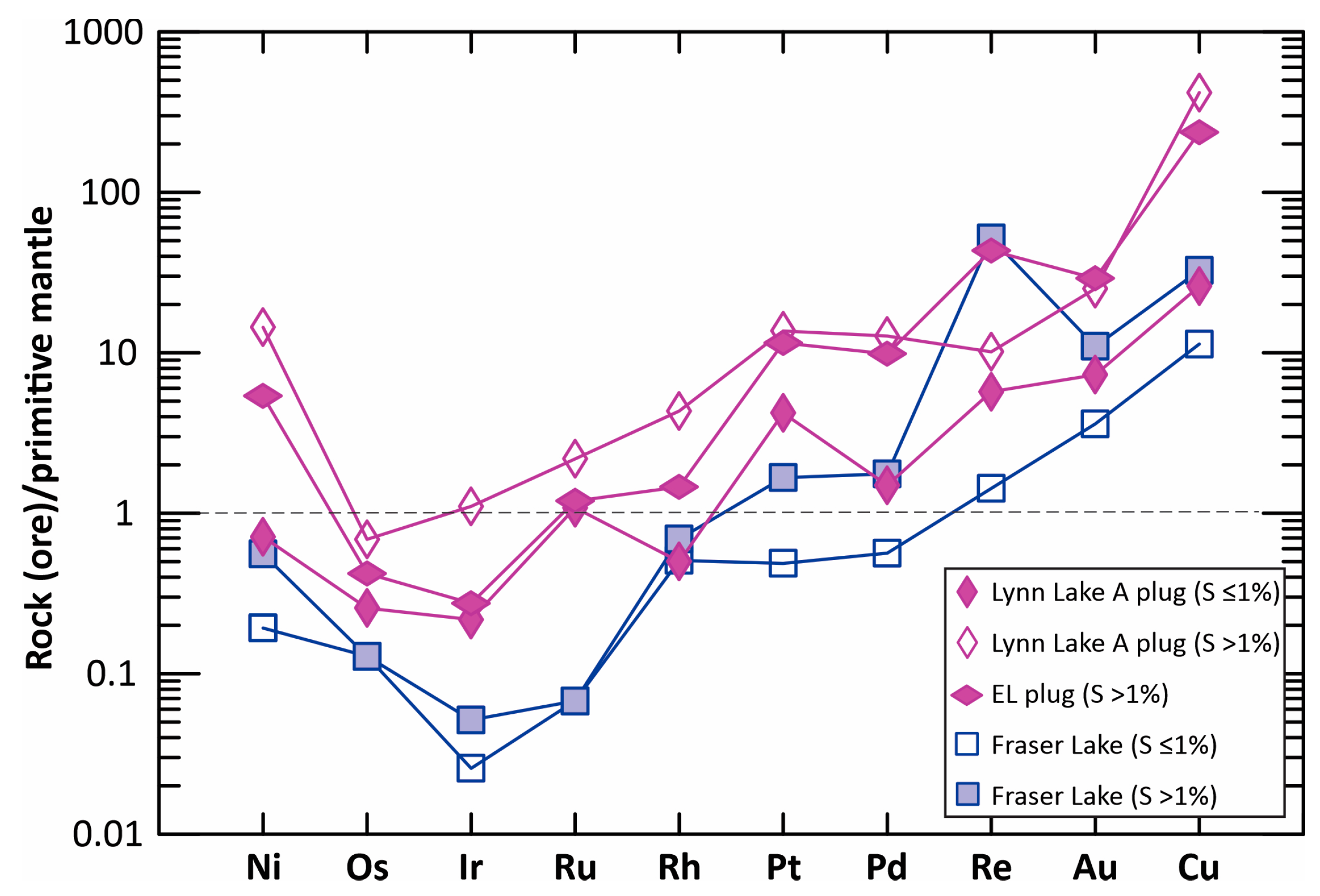
5.4. Platinum Group Elements (PGEs)

5.5. Sulfur and Oxygen Stable Isotope Compositions
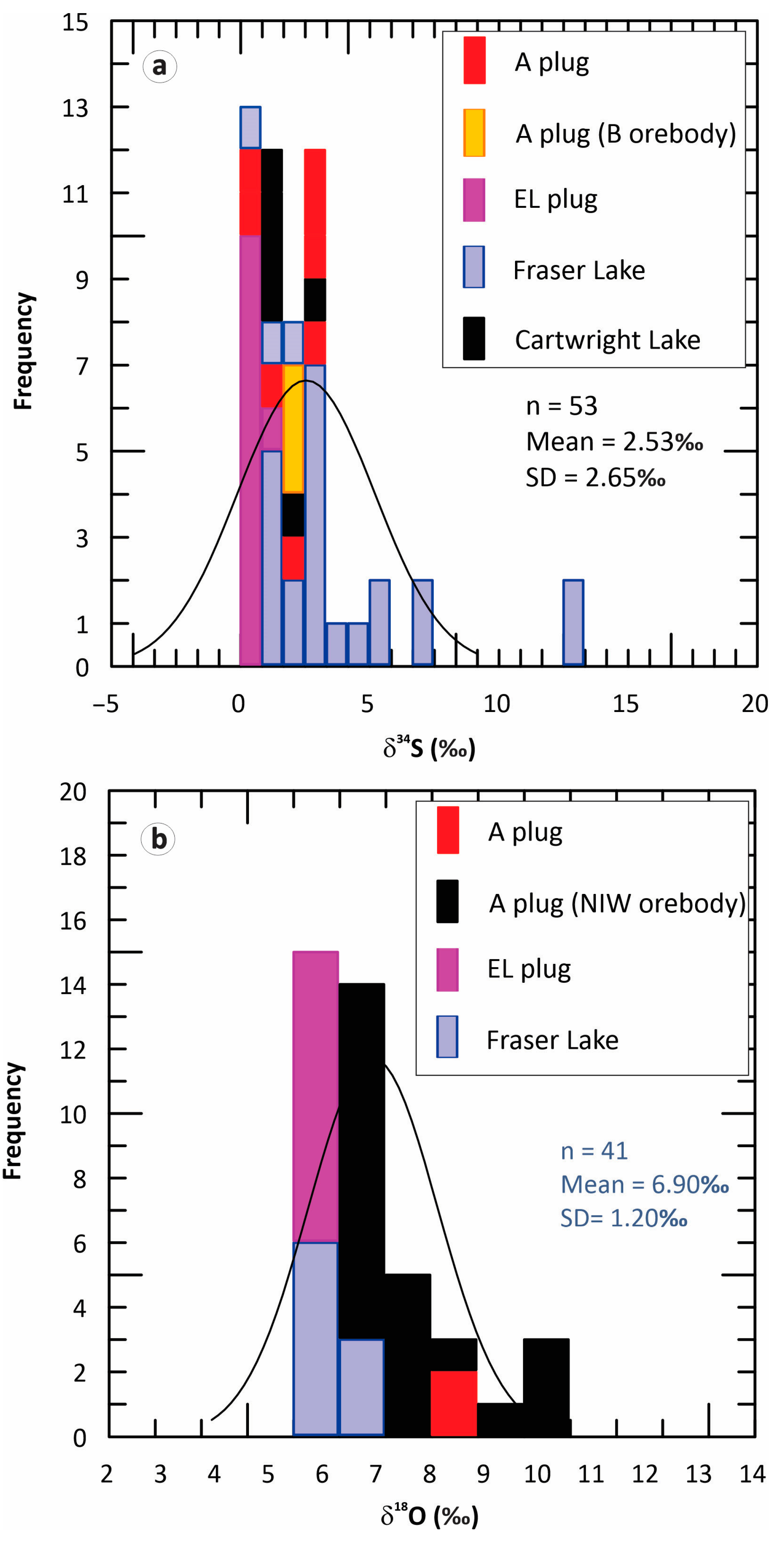
6. Discussion
6.1. Mantle Source
6.2. Magmatic Fractionation
6.3. Crustal Contamination
6.4. Tectonic and Structural Controls
7. Conclusions
Supplementary Materials
Funding
Data Availability Statement
Acknowledgments
Conflicts of Interest
References
- Lightfoot, P.C. Nickel Sulfide Ores and Impact Melts: Origin of the Sudbury Igneous Complex; Elsevier: Amsterdam, The Netherlands, 2017; pp. 1–662. [Google Scholar]
- Lightfoot, P.C.; Naldrett, A.J.; Gorbachev, N.S.; Doherty, W.; Fedorenko, V.A. Geochemistry of the Siberian Trap of the Noril’sk area, USSR, with implications for the relative contributions of crust and mantle to flood basalt magmatism. Contrib. Mineral. Petrol. 1990, 104, 631–644. [Google Scholar] [CrossRef]
- Lightfoot, P.C.; Stewart, R.; Gribbin, G.; Mooney, S.J. Relative contribution of magmatic and post-magmatic processes in the genesis of the Thompson Mine Ni-Co sulfide ores, Manitoba, Canada. Ore Geol. Rev. 2017, 83, 258–286. [Google Scholar] [CrossRef]
- Naldrett, A.J. Magmatic Sulfide Deposits: Geology, Geochemistry and Exploration; Springer: Berlin, Germany, 2004; pp. 1–727. [Google Scholar]
- Barnes, S.-J.; Lightfoot, P.C. Formation of magmatic nickel-sulfide ore deposits and processes affecting their copper and platinum-group element contents. In Economic Geology 2005, 100th Anniversary Volume; Hedenquist, J.W., Thompson, J.F.H., Goldfarb, R.J., Richards, J.P., Eds.; Society of Economic Geologists: Littleton, CO, USA, 2005; pp. 179–213. [Google Scholar]
- Houlé, M.G.; Gibson, H.L.; Lesher, C.M.; Davis, P.C.; Cas, R.A.F.; Beresford, S.W.; Arndt, N.T. Komatiitic sills and multigenerational peperite at Dundonald Beach, Abitibi greenstone belt, Ontario: Volcanic architecture and nickel sulfide distribution. Econ. Geol. 2008, 103, 1269–1284. [Google Scholar] [CrossRef]
- Begg, G.C.; Hronsky, J.A.M.; Arndt, N.T.; Griffin, W.L.; O’Reilly, S.Y.; Hayward, N. Lithospheric, cratonic, and geodynamic setting of Ni-Cu-PGE sulfide deposits. Econ. Geol. 2010, 105, 1057–1070. [Google Scholar] [CrossRef]
- Barnes, S.J.; Malitch, K.N.; Yudovskaya, M.A. Introduction to a Special Issue on the Norilsk-Talnakh Ni-Cu-platinum group element deposits. Econ. Geol. 2020, 115, 1157–1172. [Google Scholar] [CrossRef]
- Maxeiner, R.O.; Rayner, N.M. Geology, U-Pb zircon geochronology, and geochemistry of PGE-bearing Neoarchean and Paleoproterozoic gabbroic rocks of the Peter Lake domain, southern Hearne craton, Canada. Can. J. Earth Sci. 2017, 54, 587–608. [Google Scholar] [CrossRef]
- Yildirim, E.; Yildirim, N.; Dönmez, C.; Günay, K.; Korkmaz, T.; Akyildiz, M.; Gören, B. Composition of Pancarli magmatic Ni-Cu ± (PGE) sulfide deposit in the Cadomian-Avalonian Belt, eastern Turkey. J. Earth Sci. 2020, 31, 536–550. [Google Scholar] [CrossRef]
- Deng, Y.-F.; Song, X.-Y.; Xie, W.; Chen, L.-M.; Yu, S.-Y.; Yuan, F.; Hollings, P.; Wei, S. The role of external sulfur in triggering sulfide immiscibility at depth: Evidence from the Huangshan-Jingerquan Ni-Cu metallogenic belt, NW China. Econ. Geol. 2022, 117, 1867–1879. [Google Scholar] [CrossRef]
- U.S. Geological Survey. Nickel―Mineral Commodity Summaries 2023. Available online: https://pubs.usgs.gov/periodicals/mcs2023/mcs2023-nickel.pdf (accessed on 10 September 2023).
- Pinsent, R.H. Nickel-Copper Mineralization in the Lynn Lake Gabbro. Manitoba Energy and Mines, Geological Services, Economic Geology Report ER79-3, 1980. pp. 1–138. Available online: https://manitoba.ca/iem/info/libmin/ER79-3.pdf (accessed on 20 May 2023).
- Gilbert, H.P.; Syme, E.C.; Zwanzig, H.V. Geology of the Metavolcanic and Volcaniclastic Metasedimentary Rocks in the Lynn Lake Area; Manitoba Energy and Mines, Mineral Resources Division, Geological Paper GP80-1, 1980. pp. 1–118. Available online: https://manitoba.ca/iem/info/libmin/GP80-1.zip (accessed on 10 October 2021).
- Syme, E.C. Geochemistry of Metavolcanic Rocks in the Lynn Lake Belt; Manitoba Energy and Mines, Geological Services/Mines Branch, Geological Report GR84-1; Manitoba Geological Services/Mine: Winnipeg, MB, Canada, 1985; pp. 1–84. [Google Scholar]
- Gilbert, H.P. Geology of the Barrington Lake-Melvin Lake-Fraser Lake Area; Manitoba Energy and Mines, Geological Services, Geological Report GR87-3, 1993. pp. 1–97. Available online: https://manitoba.ca/iem/info/libmin/GR87-3.zip (accessed on 13 October 2021).
- Zwanzig, H.V.; Syme, E.C.; Gilbert, H.P. Updated Trace Element Geochemistry of ca. 1.9 Ga Metavolcanic Rocks in the Paleoproterozoic Lynn Lake Belt; Manitoba Industry, Trade and Mines, Geological Services, Open File Report OF99-13, 1999. pp. 1–46. Available online: https://manitoba.ca/iem/info/libmin/OF99-13.zip (accessed on 22 October 2021).
- Yang, X.M.; Beaumont-Smith, C.J. Geological Investigations of the Keewatin River Area, Lynn Lake Greenstone Belt, Northwestern Manitoba (Parts of NTS 64C14, 15). Report of Activities 2015, Manitoba Mineral Resources, Manitoba Geological Survey; pp. 68–78. Available online: https://manitoba.ca/iem/geo/field/roa15pdfs/GS-4.pdf (accessed on 15 October 2021).
- Glendenning, M.W.P.; Gagnon, J.E.; Polat, A. Geochemistry of the metavolcanic rocks in the vicinity of the MacLellan Au-Ag deposit and an evaluation of the tectonic setting of the Lynn Lake greenstone belt, Canada: Evidence for a Paleoproterozoic-aged rifted continental margin. Lithos 2015, 233, 46–68. [Google Scholar] [CrossRef]
- Hastie, E.C.G.; Gagnon, J.E.; Samson, I.M. The Paleoproterozoic MacLellan deposit and related Au-Ag occurrences, Lynn Lake greenstone belt, Manitoba: An emerging, structurally controlled gold camp. Ore Geol. Rev. 2018, 94, 24–45. [Google Scholar] [CrossRef]
- Lawley, C.J.M.; Yang, X.M.; Selby, D.; Davis, W.; Zhang, S.; Petts, D.C.; Jackson, S.E. Sedimentary basin controls on orogenic gold deposits: New constraints from U-Pb detrital zircon and Re-Os sulphide geochronology, Lynn Lake greenstone belt, Canada. Ore Geol. Rev. 2020, 126, 103790. [Google Scholar] [CrossRef]
- Lawley, C.J.M.; Schneider, D.A.; Camacho, A.; McFarlane, C.R.M.; Davis, W.J.; Yang, X.M. Post-Orogenic exhumation triggers gold mobility in the Trans-Hudson orogen: New geochronology results from the Lynn Lake Greenstone Belt, Manitoba, Canada. Precambrian Res. 2023, 395, 107127. [Google Scholar] [CrossRef]
- Yang, X.M. Preliminary Results of Bedrock Geological Mapping in the Fox Mine−Snake Lake Area, Lynn Lake Greenstone Belt, Northwestern Manitoba (Part of NTS 64C12). Report of Activities 2022, Manitoba Natural Resources and Northern Development, Manitoba Geological Survey. pp. 71–86. Available online: https://manitoba.ca/iem/geo/field/roa22pdfs/GS2022-9.pdf (accessed on 18 November 2022).
- Hoffman, P.H. United plates of America, the birth of a craton: Early Proterozoic assembly and growth of Laurentia. Annu. Rev. Earth Planet. Sci. 1988, 16, 543–603. [Google Scholar] [CrossRef]
- Corrigan, D.; Galley, A.G.; Pehrsson, S. Tectonic evolution and metallogeny of the southwestern Trans-Hudson Orogen. In Mineral Deposits of Canada: A Synthesis of Major Deposit-Types, District Metallogeny, the Evolution of Geological Provinces, and Exploration Methods; Goodfellow, W.D., Ed.; Geological Association of Canada, Mineral Deposits Division, Special Publication 5 ; Geological Association of Canada: St. John’s, NL, Canada, 2007; pp. 881–902. [Google Scholar]
- Corrigan, D.; Pehrsson, S.; Wodicka, N.; de Kemp, E. The Palaeoproterozoic Trans-Hudson Orogen: A prototype of modern accretionary processes. In Ancient Orogens and Modern Analogues; Murphy, J.B., Keppie, J.D., Hynes, A.J., Eds.; Geological Society of London, Special Publications; Geological Society of London: London, UK, 2009; Volume 327, pp. 457–479. [Google Scholar]
- Corrigan, D. Paleoproterozoic crustal evolution and tectonic processes: Insights from the LITHOPROBE program in the Trans-Hudson orogen, Canada; Chapter 4. In Tectonic Styles in Canada: The LITHOPROBE Perspective; Percival, J.A., Cook, F.A., Clowes, R.M., Eds.; Geological Association of Canada, Special Paper 2012; Geological Association of Canada: St. John’s, NL, Canada; Volume 49, pp. 237–284.
- Zwanzig, H.V.; Bailes, A.H. Geology and Geochemical Evolution of the Northern Flin Flon and Southern Kisseynew Domains, Kississing–File Lakes Area, Manitoba (Parts of NTS 63K, N); Manitoba Innovation, Energy and Mines, Manitoba Geological Survey, Geoscientific Report GR2010-1, 2010. pp. 1–135. Available online: https://manitoba.ca/iem/info/libmin/GR2010-1.zip (accessed on 15 October 2021).
- Hulbert, L.J.; Scoates, R.F.J. A Map of Magmatic Nickel, Copper ± Platinum Group Element Occurrences and Mafic-Ultramafic Intrusions in Manitoba; Manitoba Industry, Trade and Mines, Economic Geology Report ER2000-1, 2000, CD-ROM. Available online: https://manitoba.ca/iem/info/libmin/ER2000-1.zip (accessed on 30 May 2023).
- Peck, D.C.; Theyer, P.; Hulbert, L.; Xiong, J.; Fedikow, M.A.F.; Cameron, H.D.M. Preliminary Exploration Database for Platinum-Group Elements in Manitoba; Manitoba Industry, Trade and Mines, Manitoba Geological Survey, Open File OF2000-5, 2000, CD-ROM. Available online: https://manitoba.ca/iem/info/libmin/OF2000-5.zip (accessed on 30 May 2023).
- Beaumont-Smith, C.J. Geochemistry Data for the Lynn Lake Greenstone Belt, Manitoba (NTS 64C11–16); Manitoba Science, Technology, Energy and Mines, Manitoba Geological Survey, Open File OF2007-1, 2008. pp. 1–5. Available online: https://manitoba.ca/iem/info/libmin/OF2007-1.zip (accessed on 10 October 2021).
- Lewry, J.F.; Collerson, K.D. The Trans-Hudson Orogen: Extent, subdivisions and problems. In The Early Proterozoic Trans-Hudson Orogen of North America; Lewry, J.F., Stauffer, M.R., Eds.; Geological Association of Canada, Special Paper 37; Geological Association of Canada: St. John’s, NL, Canada, 1990; pp. 1–14. [Google Scholar]
- Ansdell, K.M. Tectonic evolution of the Manitoba-Saskatchewan segment of the Paleoproterozoic Trans-Hudson Orogen, Canada. Can. J. Earth Sci. 2005, 42, 741–759. [Google Scholar] [CrossRef]
- Martins, T.; Rayner, N.; Corrigan, D.; Kremer, P. Regional geology and tectonic framework of the Southern Indian domain, Trans-Hudson orogen, Manitoba. Can. J. Earth Sci. 2022, 59, 371–388. [Google Scholar] [CrossRef]
- Baldwin, D.A.; Syme, E.C.; Zwanzig, H.V.; Gordon, T.M.; Hunt, P.A.; Stevens, R.P. U-Pb zircon ages from the Lynn Lake and Rusty Lake metavolcanic belts, Manitoba: Two ages of Proterozoic magmatism. Can. J. Earth Sci. 1987, 24, 1053–1063. [Google Scholar] [CrossRef]
- Beaumont-Smith, C.J.; Böhm, C.O. Structural Analysis and Geochronological Studies in the Lynn Lake Greenstone Belt and Its Gold-Bearing Shear Zones (NTS 64C10, 11, 12, 14, 15 and 16), Manitoba. Report of Activities 2002, Manitoba Industry, Trade and Mines, Manitoba Geological Survey. pp. 159–170. Available online: https://manitoba.ca/iem/geo/field/roa02pdfs/GS-19.pdf (accessed on 25 October 2021).
- Beaumont-Smith, C.J.; Böhm, C.O. Tectonic Evolution and Gold Metallogeny of the Lynn Lake Greenstone Belt, Manitoba (NTS 64C10, 11, 12, 14, 15 and 16). Report of Activities 2003, Manitoba Industry, Economic Development and Mines, Manitoba Geological Survey. pp. 39–49. Available online: https://manitoba.ca/iem/geo/field/roa03pdfs/GS-06.pdf (accessed on 25 October 2021).
- Beaumont-Smith, C.J.; Böhm, C.O. Structural Analysis of the Lynn Lake Greenstone Belt, Manitoba (NTS 64C10, 11, 12, 14, 15 and 16). Report of Activities 2004, Manitoba Industry, Economic Development and Mines, Manitoba Geological Survey. pp. 55–68. Available online: https://manitoba.ca/iem/geo/field/roa04pdfs/GS-06.pdf (accessed on 25 October 2021).
- Manitoba Energy and Mines. Granville Lake, NTS 64C; Manitoba Energy and Mines, Minerals Division, Bedrock Geology Compilation Map 64C, 1986, scale 1:250,000. Available online: https://manitoba.ca/iem/info/libmin/bgcms/bgcms_granville_lake.pdf (accessed on 5 October 2022).
- Turek, A.; Woodhead, J.; Zwanzig, H.V. U-Pb Age of the Gabbro and Other Plutons at Lynn Lake (Part of NTS 64C). Report of Activities 2000, Manitoba Industry, Trade and Mines, Manitoba Geological Survey. pp. 97–104. Available online: https://manitoba.ca/iem/geo/field/roa00pdfs/00gs-18.pdf (accessed on 15 October 2021).
- Beaumont-Smith, C.J.; Machado, N.; Peck, D.C. New Uranium-Lead Geochronology Results from the Lynn Lake Greenstone Belt, Manitoba (NTS 64C11–16); Manitoba Science, Technology, Energy and Mines, Manitoba Geological Survey, Geoscientific Paper GP2006-1, 2006. pp. 1–11. Available online: https://manitoba.ca/iem/info/libmin/GP2006-1.pdf (accessed on 11 October 2021).
- Jones, L.R.; Lafrance, B.; Beaumont-Smith, C.J. Structural controls on gold mineralization at the Burnt Timber Mine, Lynn Lake Greenstone Belt, Trans-Hudson Orogen, Manitoba. Explor. Min. Geol. 2006, 15, 89–100. [Google Scholar] [CrossRef]
- Yang, X.M.; Beaumont-Smith, C.J. Geological Investigations in the Farley Lake Area, Lynn Lake Greenstone Belt, Northwestern Manitoba (Part of NTS 64C16). Report of Activities 2016, Manitoba Growth, Enterprise and Trade, Manitoba Geological Survey. pp. 99–114. Available online: https://manitoba.ca/iem/geo/field/roa16pdfs/GS-9.pdf (accessed on 25 October 2021).
- Yang, X.M.; Beaumont-Smith, C.J. Geological Investigations of the Wasekwan Lake Area, Lynn Lake Greenstone Belt, Northwestern Manitoba (Parts of NTS 64C10, 15). Report of Activities 2017, Manitoba Growth, Enterprise and Trade, Manitoba Geological Survey. pp. 117–132. Available online: https://manitoba.ca/iem/geo/field/roa17pdfs/GS2017-11.pdf (accessed on 25 October 2021).
- Zwanzig, H.V. Geochemistry and Tectonic Framework of the Kisseynew Domain-Lynn Lake Belt Boundary (Part of NTS 63P/13). Report of Activities 2000, Manitoba Industry, Trade and Mines, Manitoba Geological Survey. pp. 91–96. Available online: https://manitoba.ca/iem/geo/field/roa00pdfs/00gs-17.pdf (accessed on 25 October 2021).
- White, D.J.; Zwanzig, H.V.; Hajnal, Z. Crustal suture preserved in the Paleoproterozoic Trans-Hudson orogeny, Canada. Geology 2000, 28, 527–530. [Google Scholar] [CrossRef]
- Fedikow, M.A.F.; Gale, G.H. Mineral Deposit Studies in the Lynn Lake Area. Report of Field Activities 1982, Manitoba Department of Energy and Mines, Mineral Resources Division. pp. 44–54. Available online: https://manitoba.ca/iem/geo/field/rfa1982.pdf (accessed on 30 October 2022).
- Baldwin, D.A. Mineral Deposits and Occurrences in the Lynn Lake Area, NTS 64C/14; Manitoba Energy and Mines, Geological Services, Mineral Deposit Series Report No. 6, 1989. pp. 1–130. Available online: https://manitoba.ca/iem/info/libmin/MDS6.zip (accessed on 7 September 2023).
- Ferreira, K.J. Mineral Deposits and Occurrences in the Laurie Lake Area, NTS 64C/12; Manitoba Energy and Mines, Geological Services, Mineral Deposit Series, Report No. 9, 1993. pp. 1–101. Available online: https://manitoba.ca/iem/info/libmin/MDS9.zip (accessed on 18 September 2022).
- Yang, X.M. Preliminary Results of Bedrock Mapping in the Gemmell Lake Area, Lynn Lake Greenstone Belt, Northwestern Manitoba (Parts of NTS 64C11, 14). Report of Activities 2019, Manitoba Agriculture and Resource Development, Manitoba Geological Survey. pp. 10–29. Available online: https://manitoba.ca/iem/geo/field/roa19pdfs/GS2019-2.pdf (accessed on 5 October 2021).
- Yang, X.M. Bedrock Mapping at Ralph Lake, Lynn Lake Greenstone Belt, Northwestern Manitoba (Part of NTS 64C14): Preliminary Results and Geological Implications. Report of Activities 2021, Manitoba Agriculture and Resource Development, Manitoba Geological Survey. pp. 40–58. Available online: https://manitoba.ca/iem/geo/field/roa21pdfs/GS2021-5.pdf (accessed on 22 November 2021).
- Manitoba Agriculture and Resource Development. Lynn Lake, Manitoba (NTS 64C14); Manitoba Agriculture and Resource Development, Manitoba Geological Survey, Lynn Lake Bedrock Compilation Map 64C14, 2021, scale 1:50,000. Available online: https://manitoba.ca/iem/info/libmin/lynn_lake_compilation_2021.zip (accessed on 15 October 2021).
- Yang, X.M. Field Relationships, Geochemical Characteristics and Metallogenic Implications of Gabbroic Intrusions in the Paleoproterozoic Lynn Lake Greenstone Belt, Northwestern Manitoba (Parts of NTS 64C10–12, 14–16). Report of Activities 2023, Manitoba Economic Development, Investment, Trade and Natural Resources, Manitoba Geological Survey. pp. 73–89. Available online: https://www.manitoba.ca/iem/geo/field/roa23pdfs/GS2023-9.pdf (accessed on 19 November 2023).
- Childs, G.D. The Petrology of the Myrna Lake and Fraser Lake Basic Intrusive Bodies. Master’s Thesis, University of Manitoba, Winnipeg, MB, Canada, 1950; pp. 1–102. [Google Scholar]
- Dunsmore, D.J. A Paleomagnetic Study of the Lynn Lake and Fraser Lake Gabbros, Northern Manitoba. Master’s Thesis, University of Windsor, Windsor, ON, Canada, 1986; pp. 1–116. Available online: https://scholar.uwindsor.ca/etd/6795 (accessed on 10 June 2023).
- Hulbert, L.J. Geology of the Fraser Lake Gabbro Complex, Manitoba. Master’s Thesis, University of Regina, Regina, SK, Canada, 1978; pp. 1–414. [Google Scholar]
- Middlemost, E.A.K. Naming materials in the magma/igneous rock system. Earth Sci. Rev. 1994, 37, 215–224. [Google Scholar] [CrossRef]
- Yang, X.M. Using the Rittmann Serial Index to define the alkalinity of igneous rocks. Neues Jahrb. Für Mineral. Abh. 2007, 184, 95–103. [Google Scholar]
- Irvine, T.N.; Baragar, W.R.A. A guide to the chemical classification of the common volcanic rocks. Can. J. Earth Sci. 1971, 8, 523–548. [Google Scholar] [CrossRef]
- Shand, S.J. Eruptive Rocks: Their Genesis, Composition, Classification, and Their Relation to Ore-Deposits, 3rd ed.; John Wiley & Sons: New York, NY, USA, 1947; p. 488. [Google Scholar]
- Maniar, P.D.; Piccoli, P.M. Tectonic discrimination of granitoids. Geol. Soc. Am. Bull. 1989, 101, 635–643. [Google Scholar] [CrossRef]
- Streckeisen, A. To each plutonic rock its proper name. Earth Sci. Rev. 1976, 12, 1–33. [Google Scholar] [CrossRef]
- Streckeisen, A.; Le Maitre, R.W. A chemical approach to the Modal QAPF classification of the igneous rocks. Neues Jahrb. Für Mineral. Abh. 1979, 136, 169–206. [Google Scholar]
- Pearce, J.A. A user’s guide to basalt discrimination diagrams. In Trace Element Geochemistry of Volcanic Rocks: Applications for Massive Sulphide Exploration; Wyman, D.A., Ed.; Geological Association of Canada, Short Course Notes; Geological Association of Canada: St. John’s, NL, Canada, 1996; Volume 12, pp. 79–113. [Google Scholar]
- Yang, X.M.; Lawley, C.J.M. Rapid switch in geodynamic setting revealed by episodic granitoid magmatism in the Lynn Lake greenstone belt of Paleoproterozoic Trans-Hudson Orogen, Manitoba, Canada. Lithos 2024, 470, 107534. [Google Scholar] [CrossRef]
- Yang, X.M.; Lawley, C.J.M. Tectonic Setting of the Gordon Gold Deposit, Lynn Lake Greenstone Belt, Northwestern Manitoba (Parts of NTS 64C16): Evidence from Lithogeochemistry, Nd Isotopes and U-Pb Geochronology. Report of Activities 2018, Manitoba Growth, Enterprise and Trade, Manitoba Geological Survey. pp. 89–109. Available online: https://manitoba.ca/iem/geo/field/roa18pdfs/GS2018-8.pdf (accessed on 19 October 2021).
- Sun, S.-S.; McDonough, W.F. Chemical and isotopic systematics of oceanic basalts: Implications for mantle composition and processes. In Magmatism in the Ocean Basins; Saunders, A.D., Norry, M.J., Eds.; Geological Society of London, Special Publications; Geological Society of London: London, UK, 1989; pp. 313–345. [Google Scholar]
- McDonough, W.F.; Sun, S.-S. The composition of the Earth. Chem. Geol. 1995, 120, 223–253. [Google Scholar] [CrossRef]
- Lorand, J.-P.; Pont, S.; Guttierez-Narbona, R.; Gervilla, F. Chalcophile-siderophile element systematics and regional-scale magmatic percolation in the Ronda peridotite massif (Spain). Lithos 2021, 380, 105901. [Google Scholar] [CrossRef]
- Rollinson, H.; Pease, V. Using Geochemical Data to Understand Geological Processes, 2nd ed.; Cambridge University Press: Cambridge, UK, 2021; p. 346. [Google Scholar]
- Rollinson, H.R. Using Geochemical Data: Evaluation, Presentation, Interpretation; Routledge: London, UK, 1993; p. 384. [Google Scholar]
- Orejana, D.; García-Rodríguez, M.; de Ignacio, C.; Ruiz-Molina, S. Noble and base metal geochemistry of late- to post-orogenic mafic dykes from central Spain. Mineral. Petrol. 2024, 118, 71–88. [Google Scholar] [CrossRef]
- Palme, H.; O’Neill, H. Cosmochemical estimates of mantle composition. In Treatise on Geochemistry, 2nd ed.; Holland, H.D., Turekian, K.K., Eds.; Elsevier: Oxford, UK, 2014; Volume 3, pp. 1–39. [Google Scholar]
- Yang, X.M.; Lentz, D.R. Sulfur isotopic systematics of granitoids from southwestern New Brunswick, Canada: Implications for magmatic-hydrothermal processes, redox conditions and gold mineralization. Miner. Depos. 2010, 45, 795–816. [Google Scholar] [CrossRef]
- Sakai, H.; Casadevall, T.J.; Moore, J.G. Chemistry and isotope ratios of sulfur in basalts and volcanic gases at Kilauea Volcano, Hawaii. Geochim. Cosmochim. Acta 1982, 46, 729–738. [Google Scholar] [CrossRef]
- Alexandre, P. The Solid Earth: Isotope Geochemistry. In Isotopes and the Natural Environment; Springer Textbooks in Earth Sciences, Geography and Environment; Springer: Cham, Switzerland, 2020. [Google Scholar] [CrossRef]
- Ripley, E.M.; Li, C. Sulfur isotope exchange and metal enrichment in the formation of magmatic Cu-Ni-(PGE) deposits. Econ. Geol. 2003, 98, 635–641. [Google Scholar] [CrossRef]
- Yang, X.M. Sulphur solubility in felsic magmas: Implications for genesis of intrusion-related gold mineralization. Geosci. Can. 2012, 39, 17–32. [Google Scholar]
- Mavrogenes, J.A.; O’Neill, S.C. The relative effects of pressure, temperature and oxygen fugacity on the solubility of sulfide in mafic magmas. Geochim. Cosmochim. Acta 1999, 63, 1173–1180. [Google Scholar] [CrossRef]
Disclaimer/Publisher’s Note: The statements, opinions and data contained in all publications are solely those of the individual author(s) and contributor(s) and not of MDPI and/or the editor(s). MDPI and/or the editor(s) disclaim responsibility for any injury to people or property resulting from any ideas, methods, instructions or products referred to in the content. |
© 2025 by the author. Licensee MDPI, Basel, Switzerland. This article is an open access article distributed under the terms and conditions of the Creative Commons Attribution (CC BY) license (https://creativecommons.org/licenses/by/4.0/).
Share and Cite
Yang, X.-M. Fertility of Gabbroic Intrusions in the Paleoproterozoic Lynn Lake Greenstone Belt, Manitoba, Canada: Insights from Field Relationships, Geochemical and Metallogenic Characteristics. Minerals 2025, 15, 448. https://doi.org/10.3390/min15050448
Yang X-M. Fertility of Gabbroic Intrusions in the Paleoproterozoic Lynn Lake Greenstone Belt, Manitoba, Canada: Insights from Field Relationships, Geochemical and Metallogenic Characteristics. Minerals. 2025; 15(5):448. https://doi.org/10.3390/min15050448
Chicago/Turabian StyleYang, Xue-Ming. 2025. "Fertility of Gabbroic Intrusions in the Paleoproterozoic Lynn Lake Greenstone Belt, Manitoba, Canada: Insights from Field Relationships, Geochemical and Metallogenic Characteristics" Minerals 15, no. 5: 448. https://doi.org/10.3390/min15050448
APA StyleYang, X.-M. (2025). Fertility of Gabbroic Intrusions in the Paleoproterozoic Lynn Lake Greenstone Belt, Manitoba, Canada: Insights from Field Relationships, Geochemical and Metallogenic Characteristics. Minerals, 15(5), 448. https://doi.org/10.3390/min15050448






